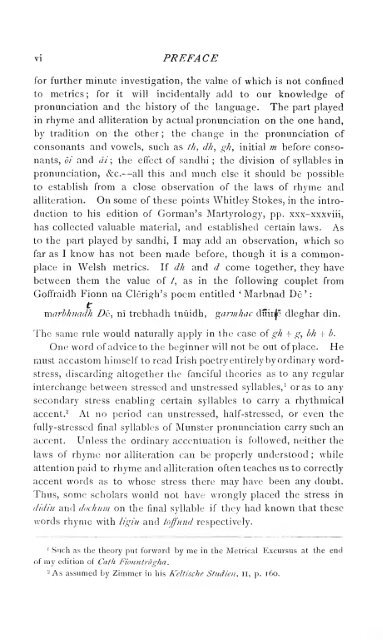A primer of Irish metrics : with a glossary, and an appendix ...
A primer of Irish metrics : with a glossary, and an appendix ...
A primer of Irish metrics : with a glossary, and an appendix ...
Create successful ePaper yourself
Turn your PDF publications into a flip-book with our unique Google optimized e-Paper software.
vi PREFACE<br />
for further minute investigation, the value <strong>of</strong> which is not confined<br />
to <strong>metrics</strong> ; for it will incidentally add to our knowledge <strong>of</strong><br />
pronunciation <strong><strong>an</strong>d</strong> the history <strong>of</strong> the l<strong>an</strong>guage. The part played<br />
in rhyme <strong><strong>an</strong>d</strong> alliteration by actual pronunciation on the one h<strong><strong>an</strong>d</strong>,<br />
by tradition on the other ; the ch<strong>an</strong>ge in the pronunciation <strong>of</strong><br />
conson<strong>an</strong>ts <strong><strong>an</strong>d</strong> vowels, such as th, dh, gh, initial m before conso-<br />
n<strong>an</strong>ts, oi <strong><strong>an</strong>d</strong> at; the effect <strong>of</strong> s<strong><strong>an</strong>d</strong>hi ; the division <strong>of</strong> syllables in<br />
pronunciation, &c.—all this <strong><strong>an</strong>d</strong> much else it should be possible<br />
to establish from a close observation <strong>of</strong> the laws <strong>of</strong> rhyme <strong><strong>an</strong>d</strong><br />
alliteration. On some <strong>of</strong> these points Whitley Stokes, in the intro-<br />
duction to his edition <strong>of</strong> Gorm<strong>an</strong>'s Martyrology, pp. xxx-xxxviii,<br />
has collected valuable material, <strong><strong>an</strong>d</strong> established certain laws. As<br />
to the part played by s<strong><strong>an</strong>d</strong>hi, I may add <strong>an</strong> observation, which so<br />
far as I know has not been made before, though it is a common-<br />
place in Welsh <strong>metrics</strong>. If dh <strong><strong>an</strong>d</strong> d come together, they have<br />
between them the value <strong>of</strong> /, as in the following couplet from<br />
G<strong>of</strong>fraidh Fionn ua Clérigh's poem entitled ' Marbnad Dé '<br />
t<br />
marbhnadk Dc, nl trebhadh tnúidh, garmhac duinjé dleghar din.<br />
The same rule would naturally apply in the case <strong>of</strong> gh + g, bh + b.<br />
One word <strong>of</strong> advice to the beginner will not be out <strong>of</strong> place. He<br />
must accustom himself to read <strong>Irish</strong> poetry entirely by ordinary word-<br />
stress, discarding altogether the f<strong>an</strong>ciful theories as to <strong>an</strong>y regular<br />
interch<strong>an</strong>ge between stressed <strong><strong>an</strong>d</strong> unstressed syllables, 1<br />
:<br />
or as to <strong>an</strong>y<br />
secondary stress enabling certain syllables to carry a rhythmical<br />
accent. 2 At no period c<strong>an</strong> unstressed, half-stressed, or even the<br />
fully-stressed final syllables <strong>of</strong> Munster pronunciation carry such <strong>an</strong><br />
accent. Unless the ordinary accentuation is followed, neither the<br />
laws <strong>of</strong> rhyme nor alliteration c<strong>an</strong> be properly understood ; while<br />
attention paid to rhyme <strong><strong>an</strong>d</strong> alliteration <strong>of</strong>ten teaches us to correctly<br />
accent words as to whose stress there may have been <strong>an</strong>y doubt.<br />
Thus, some scholars would not have wrongly placed the stress in<br />
didiu <strong><strong>an</strong>d</strong> dochum on the final syllable if they had known that these<br />
words rhyme <strong>with</strong> ligiu <strong><strong>an</strong>d</strong> t<strong>of</strong>fund respectively.<br />
1 Such as the theory put forward by me in the Metrical Excursus at the end<br />
<strong>of</strong> my edition <strong>of</strong> Cath Fionntragha.<br />
-As assumed by Zimmer in his KeUische Studien, II, p. 160.

















